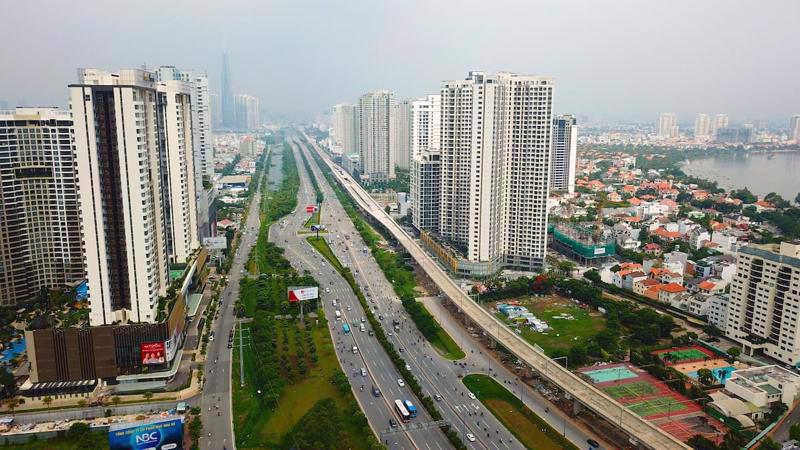Vietnam’s real estate landscape in 2022 and 2023 was defined by deep crises: a freeze in supply, plummeting liquidity, and stalled progress at numerous housing projects. Legal bottlenecks, bureaucratic inefficiencies, and cumbersome procedures contributed to delays and wasted land and capital resources, driving up costs for developers and resulting in product prices soaring. Real estate businesses were not only under financial strain but also had to rethink their strategies in order to simply survive.
The government took decisive action in response to this pressing situation, directing ministries, agencies, and local authorities to implement urgent solutions to overcome project challenges. One of the key steps was the approval of several landmark laws by the National Assembly (NA), including the amended Law on Real Estate Business 2023, the amended Law on Housing 2023, the amended Law on Bidding 2023, and the Land Law 2024.
Following that, the government and relevant ministries quickly rolled out detailed regulations, while local authorities are now working at full speed to finalize their own guidelines. The NA and the government are now actively reviewing and amending legislation or enacting new legislation covering critical areas such as urban and rural planning, investment, construction, fire safety, geology, minerals, and notarization, paving the way for a more dynamic and efficient real estate sector.
Rising demand and transactions
The real estate market saw a significant turnaround in 2024, driven by the identification and resolution of numerous obstacles. Key proposals have been carefully considered and integrated into newly-issued and upcoming legal regulations, helping the market move in a positive direction.
According to the Ministry of Construction, interest and information searches relating to real estate have surged since the beginning of 2024. Transactions in apartments, houses, and land plots have all experienced a noticeable uptick, with each quarter surpassing the previous quarter and outperforming the same period of 2023. After a spell of limited supply, the real estate market is now showing signs of positive change. Many previously delayed projects are being restarted, while new projects are being launched.
Additionally, market liquidity has been further boosted from a reduction in bank interest rates and developers offering buyer-friendly policies. A report from the Vietnam Real Estate Research Institute highlighted that the housing supply shortage is slowly being addressed. Investor confidence is strengthening, with a product absorption rate of over 70 per cent, exceeding pre-pandemic levels. The market has also seen a return of numerous real estate service companies, brokers, and investors.
However, a supply-demand imbalance lingers. The majority of supply is concentrated in the high-end segment aimed at financial investment, leaving a gap in affordable housing options for most people. Specifically, 70 per cent of new supply is in the apartment sector, with products priced at over VND50 million ($2,000) per sq m dominating the market. Affordable commercial apartments are almost non-existent.
Housing prices remain stubbornly high in both the primary and secondary markets, especially in the apartment segment.
Prices surge in three major cities
Research on apartment price indices, reflecting the average price fluctuations of 150 selected projects by the Vietnam Association of Real Estate Brokers (VARS), shows that by the end of 2024, the average selling price of projects in Hanoi had increased by 72.4 per cent compared to the second quarter of 2019. Da Nang followed, with a 49.9 per cent rise, while Ho Chi Minh City saw a slower increase, of 34.3 per cent. Primary home prices have continued to rise without signs of slowing, pushing secondary apartment prices significantly higher, to far beyond actual market value.
By the third quarter of 2024, the average price of real estate projects in Ho Chi Minh City had risen from VND49.2 million ($1,968) per sq m to VND64.2 million ($2,568) per sq m, marking a 30.6 per cent increase from the baseline.
In Da Nang, the primary apartment market witnessed an “unprecedented” surge, with over 50 per cent of new supply priced above VND80 million ($3,200) per sq m. The market index for Da Nang recorded a 46.2 per cent increase in the third quarter of 2024, surpassing Ho Chi Minh City’s growth rate. Meanwhile, in Hanoi, the average sales price for sample projects is approaching VND60 million ($2,400) per sq m, reflecting a 64 per cent increase since the second quarter of 2019.
Data from various sources also shows that the average price of primary apartments in Hanoi has skyrocketed from VND40 million ($1,600) per sq m at the start of 2022 to approximately VND72 million ($2,880) per sq m in the third quarter of 2024. Housing prices in alleyways have also surged since early 2024, and now match prices in several inner-city areas. In particular, land prices at auction, which have surged significantly beyond the starting price in some suburban areas, where transport infrastructure is still developing, are now on par with land and villa prices in projects that have seen heavy investment in infrastructure and services.
“The real estate sector accounts for 17 per cent of the country’s GDP and is interlinked with many other industries,” said Mr. Nguyen Quoc Hiep, Chairman of GP.Invest. “As such, real estate development plays a vital role in the national economy. This is why the government and the NA are working to resolve obstacles in the field. But when prices are too high, who will buy? Some apartments are now priced at VND500 million ($20,000) per sq m. That’s simply unreasonable.”
If timely intervention by relevant authorities and within legal frameworks fails to take place, property prices could continue to escalate without end. Once prices exceed the market’s capacity, and affordability becomes an issue, both businesses and the overall real estate market could face the looming threat of collapse.
Anticipating sustainable development
Resolution No. 161/2024/QH15 on continuing to enhance the effectiveness and efficiency of the implementation of policies and laws on real estate market management and social housing development was approved during the NA’s eighth session on November 23. Under the resolution, the NA instructed the government to guide ministries, sectors, and local authorities to closely monitor the real estate market and intensify research, analysis, and forecasting to quickly implement regulatory measures.
These actions are designed to regulate the market, ensure respect for market dynamics, and foster sustainable development while preventing overheating or stagnation that could disrupt the economy and have social repercussions. Moreover, measures will be introduced to diversify real estate products, harmonize supply and demand, increase the availability of affordable housing suited to the income levels of most citizens, and safeguard social welfare.
Experts predict that, starting in 2025, with a stable economy, the maturation of new policies, and the strong leadership of the NA and the government, the market will enter a new era of greater health and sustainability. With continuous improvements in legal, financial, and public investment policies, the market is anticipated to see further growth this year. Various segments are expected to recover, with luxury apartments continuing to lead, villas and townhouses becoming more active, legally clear land attracting investors, and social housing benefiting from updated regulations.
2025 will bring numerous factors driving housing prices upwards, but also marks the final year of the five-year plan (2021-2025). In this phase, businesses will need to restructure their product offerings and prioritize real market demands over focusing exclusively on the luxury segment. As a result, while housing prices are unlikely to decrease, the pace of price increases is expected to slow down.









 Google translate
Google translate